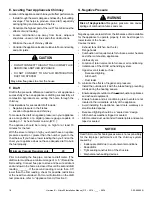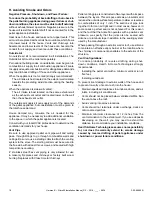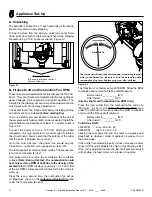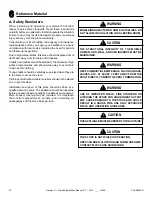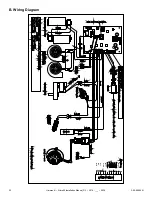
Harman® • Allure50 Installation Manual_R2 • 2016 - ___ • 09/16
18
3-90-888000i
E. Locating Your Appliance & Chimney
Location of the appliance and chimney will affect performance.
• Install through the warm airspace enclosed by the building
envelope. This helps to produce more draft, especially
during lighting and die-down of the fire.
• Penetrate the highest part of the roof. This minimizes the
effects of wind loading.
• Locate termination cap away from trees, adjacent
structures, uneven roof lines and other obstructions.
• Minimize the use of chimney offsets.
• Consider the appliance location relative to floor and ceiling
and attic joists.
G. Negative Pressure
F. Draft
Draft is the pressure difference needed to vent appliances
successfully. When an appliance is drafting successfully, all
combustion byproducts are exiting the home through the
chimney.
Considerations for successful draft include:
• Negative pressure in the firebox
• Location of appliance and chimney
To measure the draft or negative pressure on your appliance
use a magnahelic or a digital pressure gauge capable of
reading 0 - 1 inches of water column (W.C.).
The appliance should be running on high for at least 15
minutes for the test.
With the stove running on high you should have a negative
pressure equal to or greater than the number given in the
chart below. If you have a lower reading than you find on the
chart, your appliance does not have adequate draft to burn
the fuel properly.
Minimum Vacuum Requirements:
.20
Prior to installing the flue pipe, connect a draft meter. (The
draft meter must have a minimum range of 0 - .5”) Record the
first reading. Connect flue pipe to stove and be sure all doors
and windows in the home are closed. Record the second draft
reading _______. If the second reading is more than .05”
lower than the first reading, check for possible restrictions
or the need for outside air. For more information on the draft
test procedure,
refer to “Appliance Set-Up” Section C.
• DO NOT CONNECT THIS UNIT TO A CHIMNEY FLUE
SERVICING ANOTHER APPLIANCE.
• DO NOT CONNECT TO ANY AIR DISTRIBUTION
DUCT OR SYSTEM.
May allow flue gases to enter the house
CAUTION
!
Negative pressure results from the imbalance of air available
for the appliance to operate properly. It can be strongest in
lower levels of the house.
Causes include:
• Exhaust fans (kitchen, bath, etc.)
• Range hoods
• Combustion air requirements for furnaces, water heaters
and other combustion appliances.
• Clothes dryers
• Location of return-air vents to furnace or air conditioning.
• Imbalances of the HVAC air handling system.
• Upper level air leaks such as:
- Recessed lighting
- Attic hatch
- Duct leaks
To minimize the effects of negative air pressure:
• Install the outside air kit with the intake facing prevailing
winds during the heating season.
• Ensure adequate outdoor air for
all
combustion appliances
and exhaust equipment.
• Ensure furnace and air conditioning return vents are not
located in the immediate vicinity of the appliance.
• Avoid installing the appliance near doors, walkways or
small isolated spaces.
• Recessed lighting should be a “sealed can” design.
• Attic hatches weather stripped or sealed.
• Attic mounted duct work and air handler joints and seams
taped or sealed
Risk of Asphyxiation!
Negative pressure can cause
spillage of combustion fumes and soot.
WARNING
!
NOTICE
Hearth & Home Technologies assumes no responsibility
for the improper performance of the chimney system
caused by:
• Inadequate draft due to environmental conditions
• Downdrafts
• Tight sealing construction of the structure
• Mechanical exhausting devices















